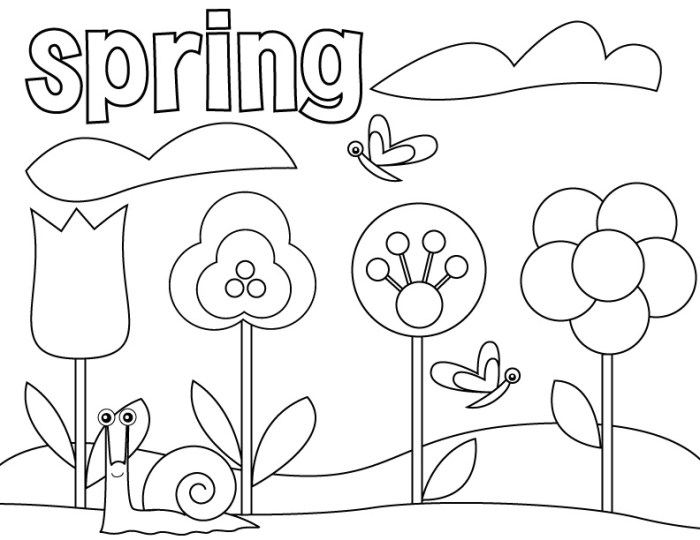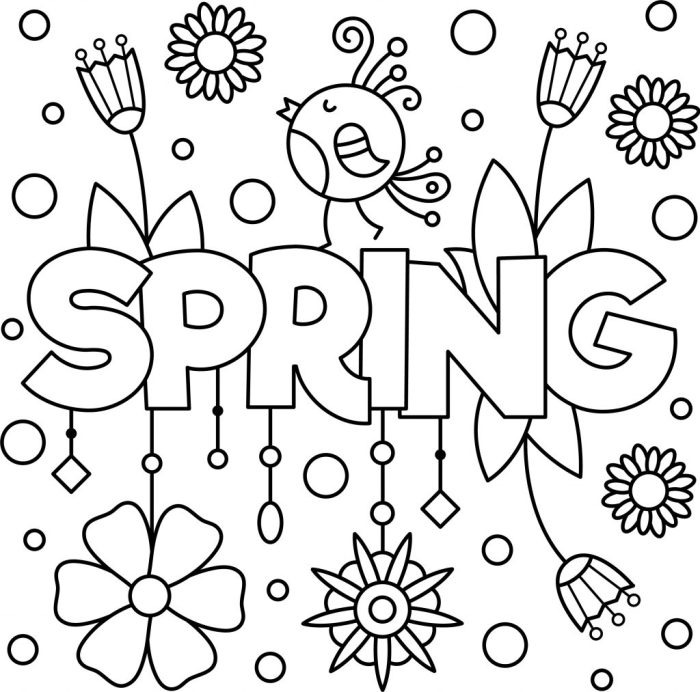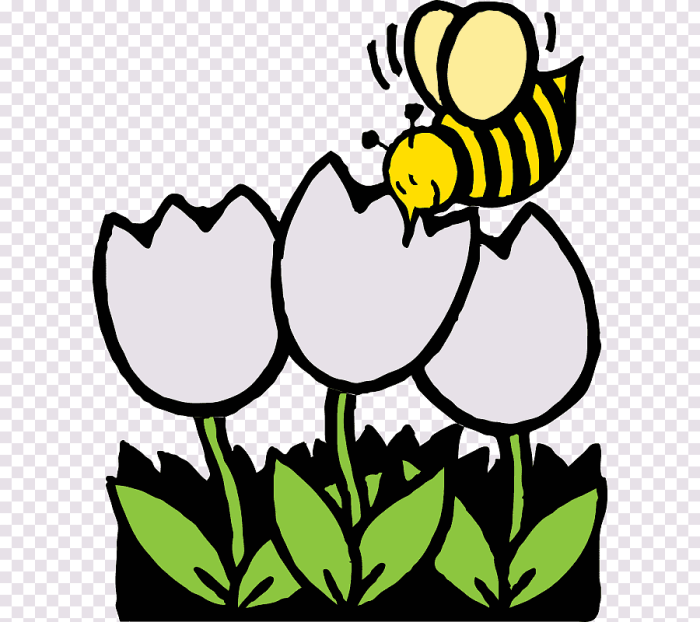Popularity and Trends of Easy Spring Coloring Pages
Spring-themed coloring pages enjoy significant popularity, particularly among young children and their caregivers. This enduring appeal stems from the inherent joy of creative expression and the association of spring with vibrant colors and delightful imagery. The ease of coloring these pages makes them accessible and enjoyable for a wide range of ages and skill levels.The current trends in easy spring coloring pages reflect a growing emphasis on simplicity, bold Artikels, and engaging themes.
These designs cater to the developmental stages of young children, offering opportunities for both fine motor skill development and imaginative play. The popularity of these pages is also fueled by their readily available nature, with countless free and paid options available online and in print.
Popular Spring Motifs in Easy Coloring Pages
Several recurring motifs dominate the landscape of easy spring coloring pages. These designs often feature elements that are easily recognizable and appealing to young children. Common examples include cheerful flowers (like tulips, daffodils, and sunflowers), playful butterflies, adorable bunnies, lively birds, and charming ladybugs. These motifs are consistently incorporated into designs due to their inherent visual appeal and cultural associations with spring.
The simplicity of these shapes also makes them easy to color, contributing to their enduring popularity.
Design Elements Across Different Age Groups
The design elements of easy spring coloring pages vary depending on the intended age group. Coloring pages for toddlers typically feature large, simple shapes with thick Artikels, minimizing the challenge of staying within the lines. These designs might include single, large flowers or basic animal shapes. Preschoolers’ coloring pages often incorporate slightly more intricate details, such as multiple flower petals or textured patterns within the shapes, providing a gentle increase in complexity to encourage fine motor skill development.
The color palettes also tend to be brighter and more saturated in designs for younger children.
Factors Contributing to Popularity
Several factors contribute to the widespread popularity of easy spring coloring pages. Their accessibility is a key element; many free resources are available online, making them a cost-effective activity for families. Furthermore, the therapeutic benefits of coloring are well-documented, offering a calming and engaging activity that can reduce stress and promote focus. The association of spring with renewal and positivity further enhances the appeal of these pages, creating a positive and uplifting experience for both children and adults.
The ease of use and the readily available resources, combined with the inherent therapeutic benefits and positive associations with the season, ensure the continued popularity of easy spring coloring pages.
Design Elements of Easy Spring Coloring Pages

Simple spring coloring pages are characterized by their uncomplicated designs, focusing on easily recognizable spring motifs and employing a limited number of details to ensure ease of coloring for young children. These pages prioritize large, bold shapes and clear Artikels, minimizing intricate lines or small, fiddly areas that could frustrate younger artists. The color palettes are typically bright and cheerful, reflecting the vibrancy of the season.
The design of these coloring pages should cater to the developmental stage of the intended audience, offering a balance between engaging imagery and manageable coloring complexity. A successful design promotes creativity and provides a satisfying coloring experience without overwhelming the child.
Common Spring-Related Images for Easy Coloring Pages
Selecting appropriate images is crucial for creating engaging and age-appropriate coloring pages. The following images are commonly used due to their simplicity and recognizability:
- Single flowers (tulips, daffodils, sunflowers)
- Simple butterflies
- Cartoonish birds (robins, bluebirds)
- Smiling sun faces
- Simple green leaves and grass
- Rainbows
- Bunnies
- Simple spring landscapes with a hill and a few flowers
Sample Easy Spring Coloring Page Design
Consider a coloring page featuring a large, single sunflower. The sunflower would occupy most of the page, with a large, central disc composed of numerous, simple, petal-like shapes. These shapes could be slightly varied in size and arrangement to add a touch of natural irregularity without compromising simplicity. The stem would be a single, thick line curving gently upwards, ending in a few simple, slightly serrated leaves.
The overall style would be bold and cartoonish, prioritizing clear Artikels and easily colorable areas.
Easy spring coloring pages offer a delightful way to celebrate the season’s arrival. For those seeking a more specific theme, you might enjoy the charming selection of coloring pages deer , which can easily be adapted to a springtime setting with the addition of pastel colors and blossoming flowers. Returning to the broader topic, remember that simple floral designs or playful bunnies are also fantastic options for easy spring coloring pages.
Examples of Easy Spring Coloring Page Ideas
The following table provides examples of easy spring coloring page ideas, categorized by image, complexity, suggested color palette, and age appropriateness.
| Image | Complexity | Color Palette Suggestion | Age Appropriateness |
|---|---|---|---|
| Single Tulip | Low | Reds, yellows, oranges, greens | 2-4 years |
| Butterfly | Low-Medium | Bright blues, purples, pinks, yellows | 3-5 years |
| Smiling Sun | Low | Yellows, oranges | 2-4 years |
| Simple Bird | Low-Medium | Blues, greens, yellows, browns | 3-5 years |
| Three Daffodils in a Pot | Medium | Yellows, oranges, greens | 4-6 years |
Educational Value and Benefits
Easy spring coloring pages offer a surprisingly rich array of educational benefits for young children, extending far beyond simple entertainment. They provide a fun and engaging way to develop crucial skills and enhance cognitive abilities, making them a valuable tool in both home and classroom settings. The act of coloring, particularly with simpler designs, fosters a range of developmental milestones in a playful manner.Easy spring coloring pages contribute significantly to a child’s overall development.
The repetitive fine motor movements involved in coloring strengthen hand muscles, improve hand-eye coordination, and enhance dexterity—essential skills for future writing and drawing abilities. Beyond the physical benefits, the act of choosing colors, deciding on shading techniques, and bringing the image to life stimulates creativity and problem-solving skills. Furthermore, the focused attention required for coloring helps children develop concentration and self-regulation, crucial for academic success.
Fine Motor Skill Development
Coloring within the lines, shading different areas, and controlling the pressure applied to the crayon or pencil all require precise movements. This repetitive action strengthens small muscles in the hands and fingers, improving dexterity and hand-eye coordination. Children who regularly engage in coloring activities often show improved handwriting, drawing, and other fine motor skills compared to their peers who do not.
The simple, yet deliberate, actions involved in coloring spring-themed pages—such as carefully coloring within the petals of a flower or the Artikels of a butterfly—contribute directly to this development. This translates to better preparedness for tasks requiring fine motor control later in their educational journey, such as writing, using scissors, and manipulating small objects.
Cognitive Benefits: Focus and Creativity
The act of coloring demands focus and concentration. Children must pay attention to the lines, colors, and the overall image they are creating. This sustained focus enhances their attention span and improves their ability to concentrate on tasks, which is a valuable skill for both academic and social settings. Furthermore, easy spring coloring pages often feature various elements—flowers, butterflies, birds, etc.—allowing children to express their creativity through color choices and shading techniques.
They can experiment with different color combinations, explore various shading styles, and add their own personal touches to the images, fostering self-expression and imaginative thinking. This creative process helps children develop problem-solving skills as they navigate color choices and decide how to best represent their vision on paper.
Integration into Educational Activities
Easy spring coloring pages can be easily integrated into various educational activities to enhance learning and engagement.
- Spring-themed vocabulary building: Children can color images of spring objects (flowers, birds, etc.) while learning and practicing their associated vocabulary words.
- Science lessons: Coloring pages depicting the life cycle of a butterfly or the growth of a plant can complement science lessons, reinforcing concepts visually.
- Storytelling and narrative development: Children can color a scene from a spring-themed story and then retell the story, using the coloring page as a visual aid.
- Math activities: Simple counting activities can be incorporated; for example, children can color a specific number of flowers or count the petals on a flower.
Accessibility and Availability

Easy spring coloring pages are widely accessible through various digital and physical platforms, catering to a broad range of users with differing needs and preferences. Their availability contributes significantly to their popularity as a fun and engaging activity for children and adults alike.The ease of access and diverse formats contribute to the widespread use of these coloring pages. Several factors influence the choice of platform and format, including user familiarity with technology, printing capabilities, and desired level of interactivity.
Platforms for Accessing Easy Spring Coloring Pages
Numerous websites dedicated to printable coloring pages offer a vast selection of easy spring-themed designs. These websites often categorize their offerings by age group, skill level, and theme, making it easy to find suitable options. Furthermore, several mobile applications provide access to a library of coloring pages, often with added features like digital coloring tools and the ability to save and share creations.
Examples include dedicated coloring book apps and broader craft and activity applications that include coloring page sections. Finally, some educational websites and blogs incorporate easy spring coloring pages as part of their broader resource collections, integrating them with lesson plans or seasonal activities.
Formats of Easy Spring Coloring Pages
Easy spring coloring pages are commonly available in two primary formats: printable PDF documents and online interactive versions. Printable PDFs are readily downloaded and printed, offering a tangible coloring experience. This format is particularly convenient for those without reliable internet access or a preference for physical activities. Online interactive versions, on the other hand, allow users to color digitally using a computer or tablet.
These versions often include features such as digital coloring tools, different color palettes, and the ability to save or share the finished artwork. Some websites also offer the option to print these interactive versions after coloring them digitally.
Advantages and Disadvantages of Access Methods, Easy spring coloring pages
Printable PDF coloring pages offer the advantage of being readily accessible offline, requiring no internet connection. However, they lack the interactive features of digital versions and require a printer and ink. Online interactive versions provide the benefit of immediate access, digital coloring tools, and the ability to save work. However, they necessitate a reliable internet connection and may not be suitable for everyone due to the reliance on technology.
The choice between these methods depends largely on individual needs and preferences.
Creating a Simple Printable Easy Spring Coloring Page (Text-Based Description)
Imagine a simple flower design. Start with a large circle for the flower’s center. From this circle, draw six slightly curved lines extending outwards, representing the petals. Each petal should be slightly wider at the end than at the base. Add small, simple leaves at the base of the flower, using oval shapes with pointed tips.
A thin, curved stem can extend downwards from the flower’s base. This design can be easily reproduced and adapted by children and adults alike, making it a suitable easy spring coloring page.
Creative Variations and Extensions

Easy spring coloring pages offer a fantastic foundation for creative exploration, extending far beyond simple coloring activities. By incorporating various techniques and approaches, these pages can become engaging projects that stimulate imagination and develop fine motor skills. The possibilities are numerous, allowing for personalized adaptations and diverse applications.Adding textures and patterns significantly enhances the visual appeal and complexity of these coloring pages.
This process encourages children to think about design and visual elements in a more nuanced way.
Texture and Pattern Additions
Adding textures can transform a simple flower into a realistic or even fantastical representation. For example, a simple daisy can be enhanced by adding stippling to create a fuzzy petal texture, or cross-hatching to give the center a more detailed, textured look. Patterns can also add a playful element; consider adding polka dots to a butterfly’s wings or stripes to a spring stem.
The use of different colored pencils or crayons can further enhance the textural effect, allowing for subtle shading and highlighting. Experimenting with different pressure levels while coloring can also contribute to a sense of depth and texture.
Extending Use Beyond Coloring: Craft Templates
Easy spring coloring pages readily serve as templates for a variety of craft projects. Once colored, these pages can be cut out and used to create three-dimensional objects. For instance, a colored butterfly can be cut out and glued onto a pipe cleaner body to create a mobile. Similarly, colored flowers can be transformed into greeting cards or decorations.
Adding glitter, sequins, or other embellishments further enhances the final craft. The colored pages can also be laminated and used as placemats or coasters.
Incorporating Interactive Elements
Interactive elements bring a new level of engagement to coloring pages. Adding stickers, such as glitter stickers or foam stickers depicting spring elements, can personalize the page and add a tactile dimension. Similarly, using stamps with spring-themed designs allows for the addition of repeated motifs and patterns, enhancing the overall design. This interactive approach fosters creativity and allows for personalized expressions.
The addition of small, self-adhesive jewels could add sparkle to the page, representing dewdrops or the sparkle of the sun.
Diverse Uses for Finished Coloring Pages
Finished spring coloring pages offer a variety of post-coloring applications.
- Creating personalized greeting cards for friends and family.
- Decorating a child’s bedroom or play area.
- Making bookmarks for books.
- Assembling them into a spring-themed scrapbook or journal.
- Using them as part of a classroom display.
- Framing them as artwork for display.
- Creating gift tags for presents.
